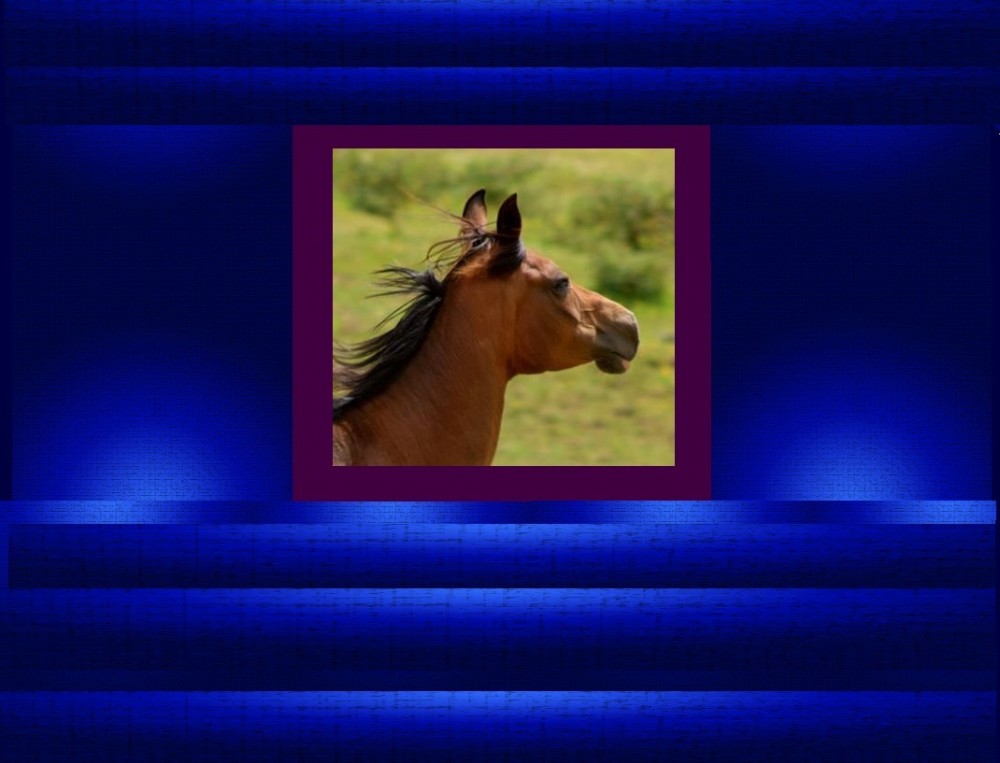PART II:
Understanding hoof deformities is a crucial part of trimming hooves. Once you understand hoof anatomy, you can tell what a normal hoof is supposed to look like. How and why hooves deform is another important piece to learn before beginning to trim hooves yourself.
One of the most common deformities is called Forward Foot Syndrome (FFS).
Hooves grow down and forward from the coronary band. You can see how the growth comes down by observing the vertical lines on the outer hoof wall. These are also known as horn tubules.

The hoof wall grows down and forward, so more of the tubules end up in the toe. The hoof wall without any wear ends up thicker in the toe.
It’s important to realize that the hoof wall grows down and forward. Otherwise you won’t think about trimming properly when you are looking at the hoof from the solar view.
More wall in the toe makes perfect sense, when you think about what part of the hoof receives the most wear when a horse is living in an abrasive environment. Hooves most often break over the front as a horse moves, so the front receives the most wear. 
What can happen is that trimmers are very good at trimming the wall of the hoof down, but don’t think about or see how the toe also has grown forward. As with this hoof: it is easy to see the “down” part, bringing the wall lower to the sole. But the toe has also gone forward, so needs to be trimmed back. That can’t be accomplished by trimming only in one dimension (horizontal to the sole).
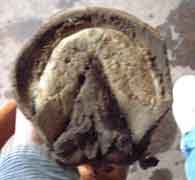
Leaving the toe long – which doesn’t just mean tall/vertical to the sole but also forward in front of/horizontal to the sole, results in leverage/force pulling on the toe laminae. As the hoof grows, and over a series of trims, this can slowly stretch the wall away from the internal foot and coffin bone, creating a laminar wedge and loss of toe connection. Of course this happens far more often and easily if the laminae are already experiencing issues from the horse having insulin resistance and chronic laminitis.
An important concept of forward foot syndrome is based on knowing the hoof anatomy. As we’ve seen, the sole grows down from the sole corium that is on the underside of the internal foot. So let’s say we have an internal hoof that is a certain size. If the toe stretches out forward, the sole corium will still only grow the same amount of sole. So that sole is forced to cover a much larger surface area, which means it will be thinner and thinner as the hoof gets larger. The internal foot doesn’t change, so the outer capsule gets distorted and unhealthy.

A healthy front hoof is round, and a healthy hind hoof is very slightly oval. The internal hoof is not oval on a front hoof. An oval hoof with a long, skinny frog has forward foot syndrome.

The coffin bone can become deformed over time, especially if heels are left contracted. Club hooves often have an oval shape due to a long term problem with contracted heels.
Another feature of forward foot syndrome is crushed or run under heels.

The low and long angulation of the hoof will often lead to heel pain from the deep digital flexor tendon rubbing over the navicular bursa or bone. The tendon can be damaged. Breakover is delayed, and can lead to issues higher up in the horse’s musculoskeletal system.

Sometimes the coffin bone even gets a negative palmar angle, meaning the back of the coffin bone sits lower than the front (ideally the back is raised at about a 3 degree angle).

Another common deformity is the club foot.

The so called “pasture foot” or high/low syndrome is a mild version of a club foot. You might be able to tell that neither of the above hooves is healthy.
People will often say to look at a horse to see if one knee or pastern is higher than the other. I’ve had farriers tell me this means the hooves need to stay at different heights. However, horses do not have any joints or bones to attach their front leg to the skeleton. They have a sling of muscles and ligaments that suspend the shoulders and chest, and no collar bone. This means that if one hoof is standing on a rock, the leg might be straight but one knee will stand higher than the other. So the height of the joint will almost always be based on the hoof height, regardless of the horse’s actual bone length. Some rare horses do have leg bones that are longer or shorter than the other. Most horses have hooves that are irregular in height but not leg bones that are different lengths.
The horse in the photo above has fetlocks that are not level because one hoof is taller than the other.
On the previous page describing hoof anatomy, you could see how long the deep digital flexor tendon is. It is held by the inferior check ligament, but if it were not able to stretch extensively, horses could not jump or gallop. Part of the efficiency of horse movement depends on the stretch and recoil of these tendons.

See how much ability to move there has to be?
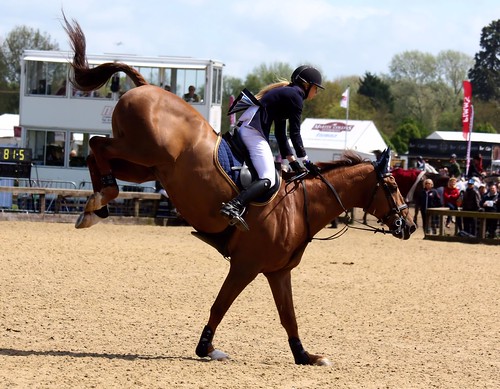
So horses with club hooves that can jump and gallop do not have a deep digital flexor tendon that is too short to lower their heel to the ground. Most vets now call a club hoof a flexural deformity. Which means it is a problem with the musculotendonous unit rather than a “contracted” tendon.
If you were to put a cast on your leg with your toe pointed down for a month or two, when you took the cast off you would not be able to put your heel on the ground without tearing muscles. That is because muscles not in use will shorten.
Horses develop a club hoof for various reasons. Often it is because of heel pain, such as an injury or thrush in the deep central sulcus. If the horse does not weight the heel between trims, it does not wear as well and the trimmer might not notice they should take more off than usual. An infection in the heel can cause the frog to contract and the contracted heel will retain extra sole, making the heel wall seem as if it is not growing.
Any pain in a heel can make the horse graze with that hoof back and the other hoof forward, causing less wear in the heel. This stance can become habitual for a horse as well. A club hoof becomes self-perpetuating. As the non-club hoof sits closer to the ground, more of the horse’s weight goes down onto that hoof. Extra weight on that side usually makes the shoulder muscle larger, and the horse will favor using that side for leads since more weight is on that side already. More use = bigger/less flexible muscles.
The club hoof heel becomes narrow, and often gets infection in the deep central sulcus even if it wasn’t there to begin with. The bars can get jammed inside the hoof, and all of this makes the heel less comfortable to land on. So the horse weights it less, and so on.
As with humans, if you want to return mobility and stretch to a contracted muscle, it must be done gradually. Farriers often say you can’t fix a club hoof. They trim the heel too far, the muscles tear, the horse can’t weight the heel, the hoof wall grows back the same length. Or they don’t trim the heel more than it is growing, so get nowhere. Or they don’t trim the bars, so the heel remains too painful for the horse to put weight on.
Here are some pictures of a hoof with the bars impacted inside the hoof. This poor digital cushion is sitting above the hoof capsule. As discussed in the anatomy section, the soft parts of the hoof can get moved around drastically by the hard parts.

Notice how the hoof wall is not long compared to the bars. This often happens in a club hoof, with the bars continuing to grow inside the hoof but the sole making it appear like there is no bar to trim. Heels that appear “too tall” must be taken down in order for the hoof to be healthy, even if it appears that there is sole filling the entire extra tall heel. As you can see with this hoof, the soft tissue gets pushed up, so there is no danger of hitting anything “live.”
When I trimmed my horse’s club hoof heel down, I found bruising deep inside even though I did not think she ever favored the hoof or showed any signs of lameness.
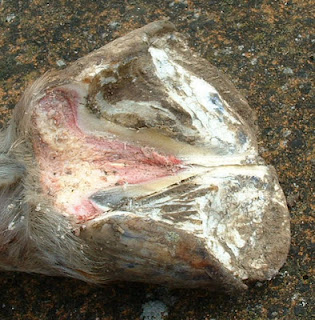
I’ve rehabbed several club hooves and have seen a few more examples in person and online of hooves that were fixed. It has to be done in short trimming cycles and the toe has to be trimmed back (it almost always has a laminar wedge) at the same time as the heel is coming down. If the hoof has a very tall heel, sole often has to be trimmed as well as wall, because the heel gets so compressed that the bars and wall don’t separate from the sole and it all grows together as one unit.
Eventually, as the hoof gets closer to normal, the wall and bars will grow normally. Most club hooves are corrected after the horse already has coffin bone remodeling, so the hoof will stay a bit oval and small. But horses will begin putting their club hoof forward when grazing, picking up that lead more easily, and show other signs of being more sound than they were previously.
I will be clear that I am talking about club hooves in adult horses, not ones in foals or from poisoning, nerve damage, or actual tendon diseases. Some club hooves are more complex. There was a case where many horses on a farm developed club hooves as adults, and it was discovered that vibrations from a nearby power plant was causing discomfort to the frogs, and the horses were not weighting their heels.
Another way hooves can become deformed is by medial/lateral imbalance.
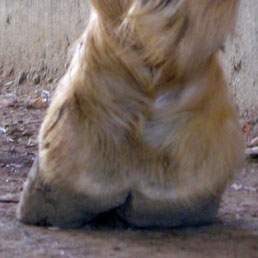
It’s actually fairly common to see horses that toe out or toe in just because they have been trimmed poorly.
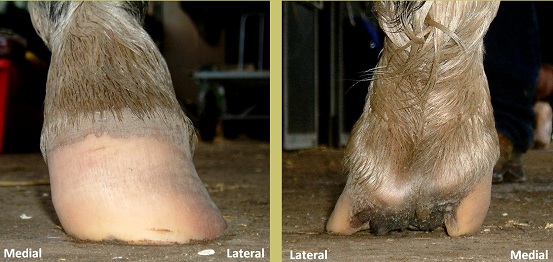
This one is pretty severe. Which side of the hoof looks longer to you? Probably the lateral side. But looking at the heel bulbs and the frog, which side sits lower to the ground? The lateral side. So taking the lateral side down and following that optical illusion will make the problem worse. Instead, the medial side should be taken lower.
A hoof like this should never be addressed without looking at the whole horse and considering first of all what body issues the horse has. However, you also need to consider the “chicken or the egg” theory because hooves that have been trimmed improperly can cause body issues.
Joints are somewhat flexible, and can be tilted to accomodate a crooked hoof until permanent damage sets in. I have seen the progression of a young horse with straight legs developing into an older horse with crooked legs due to poor trimming.
Quite a few horses are cow hocked. This can lead to the medial side of the hind hoof bearing more weight, and more wear. That heel can flare or run forward more than the other heel. This creates the above illusion, and a farrier might take that lower heel down, perpetuating the imbalance.
It is very, very important to assess whether a horse is crooked because of a crooked hoof or because of a crooked leg. Crooked hooves will create crooked legs, and over time this will cause permanent damage.
This hoof created the angle of the leg below.

When the hoof was trimmed better, the leg was better too.

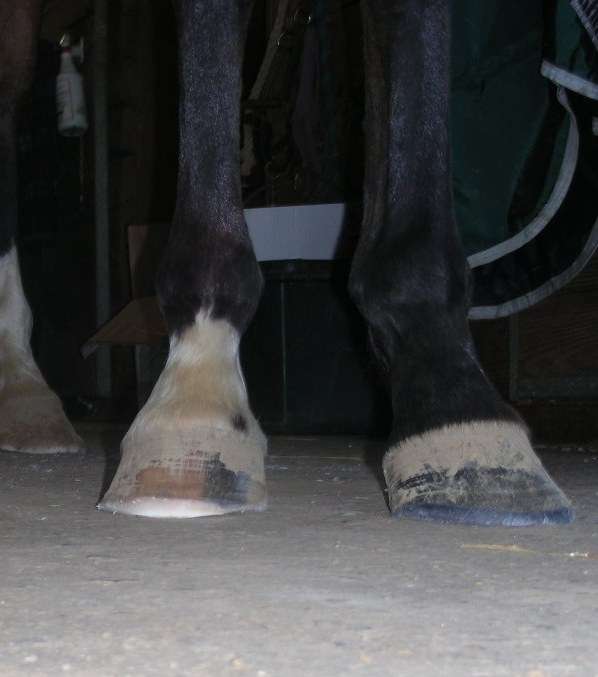 http://barefoothoofcare.net/?page_id=1352
http://barefoothoofcare.net/?page_id=1352
Leaving the hoof too long and the breakover too far forward can worsen imbalances. For example, my mare used to twist her hind legs when she walked. Once I brought her toes and breakover back, she started breaking over the toe instead of twisting as she lifted. This made her serious cowhock stance become less cowhocked, because she wasn’t wearing off the medial hoof wall with every step. Since I was addressing the medial/lateral imbalance as well, a serious imbalance that led to wall flaring between trims became a very minor imbalance that is easily corrected completely with each trim. Farriers always told me that this was due to her conformation and nothing that could be fixed.
Flaring:

Flaring can have many causes. A common reason for hoof flaring is that the hoof has been left too long between trims. Another reason is that white line disease has set in the laminae, and the connection between the inner and outer hoof wall laminae has been lost, causing the wall to pull away.
Improper trimming can cause flaring from imbalances, and so can a laminar wedge.

The above type of flaring is common in a club hoof.

Often hooves with serious flaring will be caused by any or all of the following: going too long between trims, improper nutrition, insulin resistance/sugars in the diet, poor hoof hygiene/white line disease.
It is easy to feel flaring by holding a hoof up in your hand. Running your hand down from the coronary band, flaring is felt as any deviation from a straight and tight line toward the bottom of the hoof.
Hoof cracks can be caused by a number of reasons. Any single hoof crack on occasion from hitting a stray rock is normal. Persistent or multiple hoof cracks point toward trimming imbalances, mineral imbalances or nutritional issues, or white line disease.
A horizontal hoof crack usually is from an injury to the coronary band. It will grow out on its own and just needs to be watched for signs of infection.

A hoof with an old injury to the coronary band may always grow a “seam” down the hoof. Usually these are not a problem, but might create a split at the ground level if the hooves aren’t balanced well or trimmed frequently. This hoof has a scar growing down and someone is trying to hold it together with metal.
A split like this should be considered minor, and will grow out easily as long as you don’t let white line disease set in. However, anytime there is a crack in a hoof, you should consider whether there is a laminar wedge creating a more brittle area.
Hoof cracks like these represent serious problems.
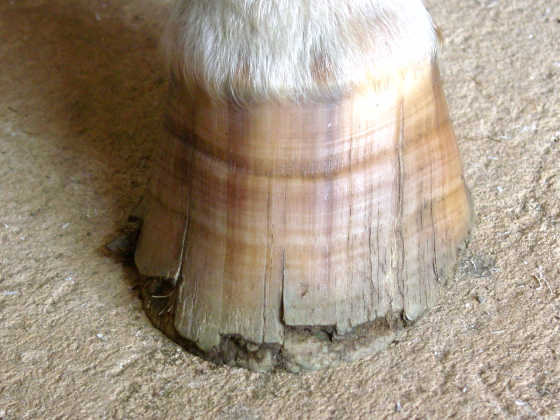
The above hoof has major white line disease.

This hoof probably represents mineral/dietary imbalances, trimming problems and possibly white line disease as well.
